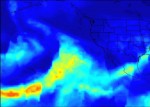
Monday, August 13th, 2018
Satellite images of phytoplankton blooms on the surface of the ocean often dazzle with their diverse colors, shades and shapes. But phytoplankton are more than just nature’s watercolors: They play a key role in Earth’s climate by removing heat-trapping carbon dioxide from the atmosphere through photosynthesis. Yet a detailed account of what becomes of that

Sunday, June 17th, 2018
Ice losses from Antarctica have tripled since 2012, increasing global sea levels by 0.12 inches (3 millimeters) in that timeframe alone, according to a major new international climate assessment funded by NASA and the European Space Agency (ESA). According to the study, ice losses from Antarctica are causing sea levels to rise faster today than

Tuesday, May 29th, 2018
A new NASA-led study shows that climate change is likely to intensify extreme weather events known as atmospheric rivers across most of the globe by the end of this century, while slightly reducing their number. The new study projects atmospheric rivers will be significantly longer and wider than the ones we observe today, leading to

Monday, April 9th, 2018
The European Space Agency (ESA) CryoSat mission revealed that, during the last seven years, Antarctica has lost an area of underwater ice the size of Greater London. This is because warm ocean water beneath the continent’s floating margins is eating away at the ice attached to the seabed. Most Antarctic glaciers flow straight into the

Tuesday, January 23rd, 2018
OceanGate Inc., a provider of manned submersible services, and 2G Robotics, which develops underwater laser scanners, formed a strategic alliance to capture laser data of the RMS Titanic shipwreck and debris field. 2G Robotics ULS-500 PRO underwater laser scanner will be installed on OceanGate’s Cyclops 2, the first manned submersible to survey the Titanic since